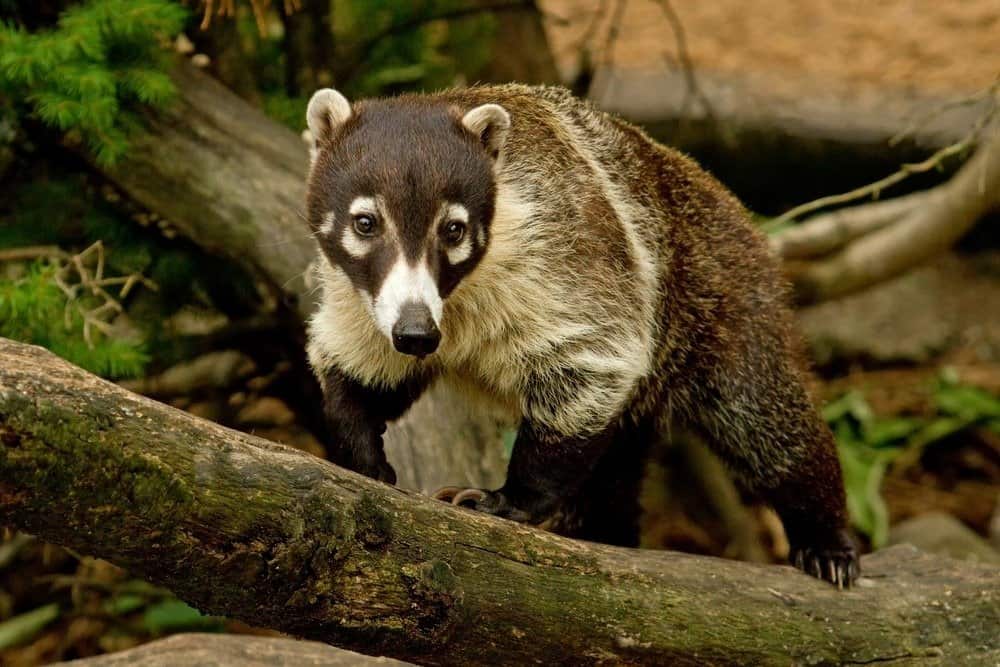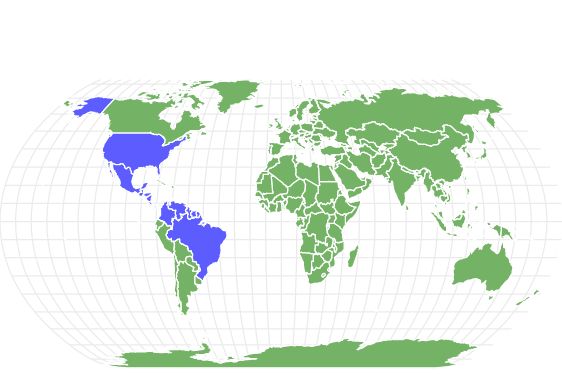Coati
.jumbotron {
background-image: url(“https://a-z-animals.com/media/coati-1-400×300.jpg”);
}
}
@media only screen and (min-width: 641px) and (max-width: 920px) {
.jumbotron {
background-image: url(“https://a-z-animals.com/media/coati-1-470×370.jpg”);
}
}
@media only screen and (min-width: 921px) {
.jumbotron {
background-image: url(“https://a-z-animals.com/media/coati-1.jpg”);
}
}
Coati
Nasua nasua
Found in dense forests and wet jungles!
Coati Scientific Classification
- Kingdom
- Animalia
- Phylum
- Chordata
- Class
- Mammalia
- Order
- Carnivora
- Family
- Procyonidae
- Genus
- Nasua
- Scientific Name
- Nasua nasua
Read our Complete Guide to Classification of Animals.
Coati Conservation Status
Coati Facts
- Main Prey
- Fruit, Nuts, Small mammals and reptiles
- Habitat
- Forests, grasslands, desert
- Predators
- Wildcats, Birds of Prey, Crocodiles
- Diet
- Omnivore
- Average Litter Size
- 4
This post may contain affiliate links to our partners like Chewy, Amazon, and others. Purchasing through these helps us further the A-Z Animals mission to educate about the world’s species..

Spiders that fly! Fish that walk! And 1000+ more incredible animals. Discover them all for FREE
.photo-gallery {
–margin: 0px auto 0px;
–padding: 0px 0px 0px 0px;
}
.gallery-link {
background-image: url(“https://a-z-animals.com/media/coati-1.jpg”);
background-repeat: no-repeat;
background-size: cover;
background-position: center;
height: 500px;
justify-content: center;
text-align: center;
align-items: center;
display: flex;
border: 2px solid #000;
}
.gallery-link img {
height: 50%;
}
@media only screen and (max-width: 768px) {
.gallery-link {
height: 300px !important;
}
}
“Coatis are related to raccoons and are also known as coatimundis“
Coatis are furry animals that are native to South America. They usually exist in Mexico, Central America, South America, and the Southwestern United States. Their name coatimundi is known to be derived from the Tupian Brazil languages.
The name ‘Coati’ originated from the Spanish word “coatí,” which goes back to Old Tupi. Their word – kua’ti – is a combination of two words: “cua” (meaning “belt”) and “tim” (meaning “nose”). The visually descriptive name is due to the coati’s habit of sticking their noses into their bellies when they sleep. The creature’s scientific name ‘Nasua’ also comes from the Latin word meaning ‘nose’.
Incredible Coati Facts
- Coatis are animals with unusually long noses help them in feeding themselves by sticking under rocks in search of food.
- Coatis usually walk with their tails high up in the air. It is used for balancing purposes while climbing.
- Coatis have double-jointed ankles that make them flexible and helps them descend trees at a much higher speed.
- These creatures make a ‘woof’ sound when they are surprised and slowly leap into the bushes in groups after that.
- Their groups can get as big as having about 30 members.
Coati Scientific Name
Coati belongs to the genus Nasua and is also called coatimundi or coatimundi. They are known to come from the family Procyonidae. There are four subspecies of coati – the mountain coati, the Ring-tailed Coati or banded tail coati, the Cozumel Island Coati, and the white-nose Coati. The name coatimundi has been derived from the Tupian Brazil languages.
Coati Appearance and Behavior
Coatis have a sleek and slender head. Their noses are the highlight of their faces and are usually long and flexible. These furry creatures have small ears, a long tail, and dark feet. They often use their tails for balancing their bodies. Their fur coats usually come in black or brown color with a lighter underpart. Coatis are about 12 inches in height and usually weigh between 4 to 18 lbs.
Their front feet are equipped with curved claws that are relatively long. The back feet, however, have shorter claws. Their toes are webbed, and they are known to be powerful swimmers. The male coati is known to be double the size of female ones and has sharp canines.
Different types of coati have slightly different behavioral characteristics. Some of them are active during the day time. While some others are active during the night. They are known to be very intelligent animals and are also very adaptable.
These creatures sleep at higher, elevated places and live in groups that can be as big as having 30 members. These groups are called bands. When surprised, these groups make a ‘woof’ noise and then leap into the bushes.
Adult coati males are especially known to be solitary creatures and join the females only at mating time. Coatis are also known to be excellent climbers and usually take the help of their tails to balance their bodies while climbing. They descend to the ground to hunt for food.

Cynthia Kidwell/Shutterstock.com
Coati Habitat
Coatis are animals that are found only in the American continent and usually live in moist or tropical rain forests. They live in elevated areas – mostly above 3000 meters – which could include pine and oak trees. Their fur coat helps them survive these conditions.
These are found in Arizona, Mexico, Central and Southern America, and the Southwestern United States. It is usually unlikely, but some coati can also be found in deserts and savannas. The ring-tailed coati is primarily found in South America, though it is also known as the South American coati or the banded tail coati.
Coati Diet
Omnivorous in nature, coatis have a diet that includes a variety of things like lizards, eggs, birds, and crocodile eggs. They also eat fruit as well as invertebrates – which they dig out from beneath the ground using their long claws. They are known to travel a lot in search of food.
Coati Predators and Threats
Like all the other animals, coatis are also a part of the environmental food chain and there are a lot of animals that prey on them. These predators include maned wolves, anacondas, tayras, dogs, and foxes. Some other animals that are known to prey on them are ocelots, raptors, eagles, jaguarundis, and boa constrictors. The pups are at particular risk for becoming the dinner of the white-headed capuchin monkey.
These creatures are also under threat due to human activities like hunting and deforestation as their natural habitat has been degenerating. Humans are also known to eat coatis which is also why the coati population is said to be on a decline. However, the species is not threatened, and the IUCN has placed it under the category of ‘least concern’.
Coati Reproduction, Babies, and Lifespan
The start of the rainy season is usually when the coati mate. The process starts when one male coati joins the band and mates with all the females. Once the baby has been conceived, the female leaves the group and builds a nest high up in the tree. The gestation period lasts for about three months after which the female gives birth to 2 to 7 babies that are called kittens.
The kittens have their eyes closed at birth and usually only open them when they are about 10 days old. Around day 19, they start standing up and can walk by day 24. Around 6 to 10 weeks of age, the kittens rejoin the band with their mothers and further care continues inside the band with the help of other female members of the group. The average coati lives for about14 years.
Coati Population
The coati population is not very clear as the species have not been studied very well. However, it has been assumed that the numbers have relatively declined because not only do these creatures fall prey to natural predators, they also face a threat from hunting and degeneration of their natural habitat due to deforestation by human beings. Humans also feed on coatis which are also known to be the reason that the coati population is on a decline in some areas.
The population varies from place to place. The greatest number of members that a band or coati group has been known to have is more than 150 members. However, they are not threatened and have been placed under the least concerned category by the IUCN.
Coati in the Zoo
Coatis can not survive in very peculiar environments and hence it would usually not be a good idea to keep them in captivity. Moreover, they are energetic animals, and keeping them in small cages wouldn’t be an appropriate thing to do. They usually require a lot of time outside.
View all 157 animals that start with C
Coati FAQs (Frequently Asked Questions)
What is a coati?
From the genus Nasua, the coati is a raccoon-like creature with a coat of fur. They are found only on the American continent and are usually distinguished by their elongated nose that helps them feed themselves while searching for food.
What does coati eat?
Coatis are omnivorous and a lot of different things make up their diet. They eat lizards, fruits, bird eggs, crocodile eggs among many other things.
Where does coati live?
They usually live in moist and tropical rainforests and can be found in Mexico, Central, and Southern America, and the Southwestern United States.
Is a coati a raccoon?
No, but the coati is related to them. However, the white-nose coati belongs to the raccoon family and is found from Arizona to South America.
Are coatis friendly?
Coatis can be friendly and can also be kept as pets. However, little is known about how they react in closed environments.
Is a coati a carnivore, herbivore, or omnivore?
A coati is omnivorous. It will eat lizards, eggs (from birds and crocodiles), and other foods found in their surroundings.
What Kingdom do Coatis belong to?
Coatis belong to the Kingdom Animalia.
What class do Coatis belong to?
Coatis belong to the class Mammalia.
What phylum to Coatis belong to?
Coatis belong to the phylum Chordata.
What family do Coatis belong to?
Coatis belong to the family Procyonidae.
What order do Coatis belong to?
Coatis belong to the order Carnivora.
What genus do Coatis belong to?
Coatis belong to the genus Nasua.
What type of covering do Coatis have?
Coatis are covered in Fur.
What are some predators of Coatis?
Predators of Coatis include wildcats, birds of prey, and crocodiles.
How many babies do Coatis have?
The average number of babies a Coati has is 4.
What is an interesting fact about Coatis?
Coatis are found in dense forests and wet jungles!
What is the scientific name for the Coati?
The scientific name for the Coati is Nasua nasua.
What is the lifespan of a Coati?
Coatis can live for 8 to 15 years.
How fast is a Coati?
A Coati can travel at speeds of up to 15 miles per hour.
How to say Coati in …
Nosál červený
Næsebjørn
Südamerikanischer Nasenbär
Ring-tailed coati
Coatí de cola anillada
Coati à queue annelée
Nasua rosso, Coati rosso
Ormányos medve
Rode neusbeer
Sør-Amerikansk nesebjørn
Ostronos rudy, Koati
Quati
Punakoati
Röd näsbjörn
Sources
- David Burnie, Dorling Kindersley (2011) Animal, The Definitive Visual Guide To The World’s Wildlife
- Tom Jackson, Lorenz Books (2007) The World Encyclopedia Of Animals
- David Burnie, Kingfisher (2011) The Kingfisher Animal Encyclopedia
- Richard Mackay, University of California Press (2009) The Atlas Of Endangered Species
- David Burnie, Dorling Kindersley (2008) Illustrated Encyclopedia Of Animals
- Dorling Kindersley (2006) Dorling Kindersley Encyclopedia Of Animals
- David W. Macdonald, Oxford University Press (2010) The Encyclopedia Of Mammals
- Wikipedia, Available here: https://en.wikipedia.org/wiki/Coati
- World Land Trust, Available here: https://www.worldlandtrust.org/species/mammals/south-american-coati/
- Sea World Parks & Entertainment, Available here: https://seaworld.org/animals/facts/mammals/coatimundi/
















